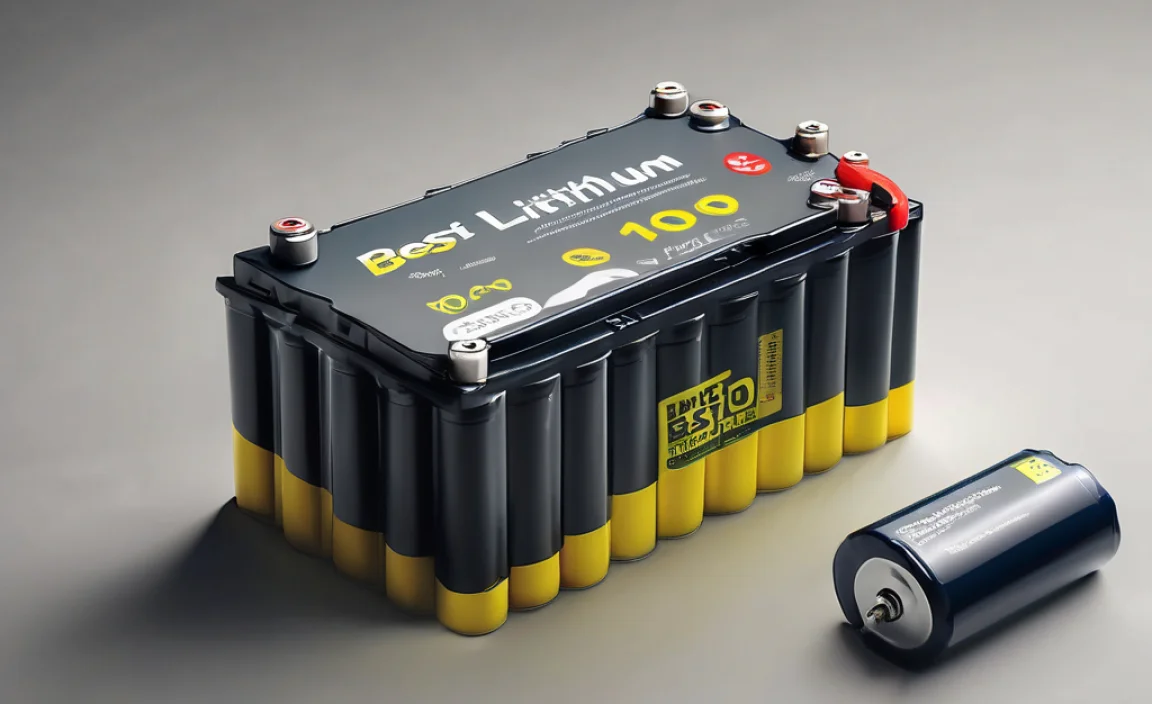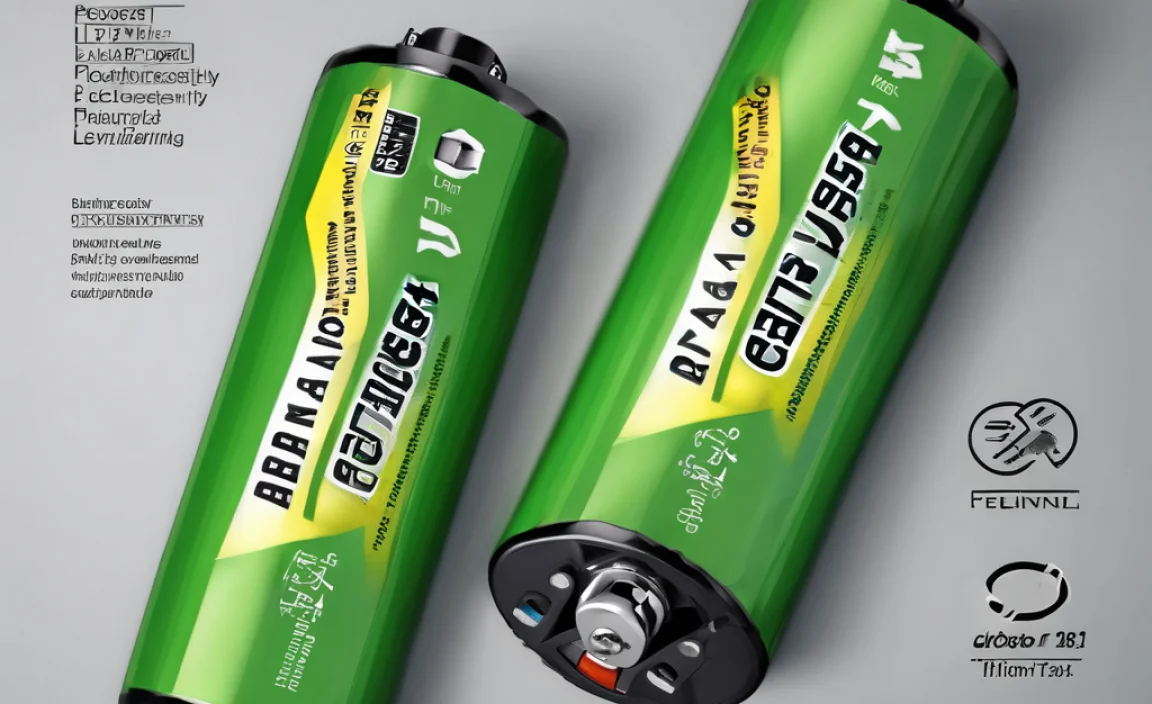Quick Summary
A battery adapter for Makita 18V tools lets you use different power sources, often newer or higher-capacity batteries, even if they don’t fit directly. This essential power solution ensures your tools stay charged and ready, extending their life and your productivity with minimal fuss.
Are your Makita 18V tools just sitting there because your batteries aren’t compatible anymore? It’s a common hassle that can stop your projects dead in their tracks. You invest in good tools, but then power issues arise. Don’t let a dead battery or a mismatched connector sideline your work.
This guide is here to make things simple. We’ll walk you through everything you need to know about battery adapters for Makita 18V tools. You’ll learn what they are, why you might need one, and how to pick the right one. We’ll cover the benefits and make sure you’re powered up and ready to go.
Let’s get your Makita tools back to their full potential!
Your Makita 18V Tools Need the Right Power: Understanding Battery Adapters
Imagine you have a fantastic set of Makita 18V cordless tools. They’re reliable, powerful, and you depend on them for everything from DIY projects around the house to professional jobs. But then, your original batteries start to fade, or you want to upgrade to a battery with more juice. Suddenly, you realize those shiny new, or even slightly different, batteries don’t quite fit. Frustrating, right? This is where a battery adapter for Makita 18V tools becomes a real game-changer.
As Roy Walker, your go-to guide for all things power, I understand how confusing battery compatibility can get. It’s like having a perfectly good car that needs a specific type of key – without it, it just won’t turn over. A battery adapter acts as that key, bridging the gap between your tool’s power input and the battery you want to use. It’s a simple yet clever piece of equipment that can save you money and keep your workflow smooth.
We’ll dive into what these adapters are, why they’re so useful, and how to choose the best one for your specific needs. We’ll also touch on safety, which is always my top priority when dealing with power. Stick around, and by the end of this, you’ll feel confident about powering up your Makita 18V gear like a pro!
What Exactly is a Makita 18V Battery Adapter?
Think of a battery adapter as a middleman. Your Makita 18V tool has a specific shape and set of electrical contacts where the battery connects. The power source you want to use – perhaps a newer Makita battery, or even a battery from a different brand that you’ve adapted – might have a slightly different physical shape or a different arrangement of electrical contacts.
A battery adapter is designed to physically connect to your tool on one side and to the battery on the other. It ensures that the electrical connections line up correctly, allowing power to flow smoothly and safely from the battery to the tool. It’s not magic; it’s smart engineering!
These adapters are typically made from durable plastic and contain the necessary metal contacts to complete the circuit. They are designed to be a snug fit, much like the original battery, so your tool doesn’t come apart during use.
Why Would You Need a Battery Adapter for Your Makita 18V Tools?
There are several common scenarios where a battery adapter becomes incredibly useful, and sometimes even essential:
Using Newer or Higher-Capacity Batteries: Makita, like many manufacturers, occasionally updates its battery lines. Newer batteries might have different form factors, even if they are still 18V. An adapter can let you use these newer, potentially longer-lasting batteries with your older tools.
Utilizing Batteries from Other Brands: This is a big one for many DIYers and professionals. Sometimes, you might have accumulated batteries from other tool brands (e.g., Dewalt, Milwaukee) that are also lithium-ion. If you find an adapter that converts one of these batteries to work with your Makita tools, you can consolidate your battery inventory and save significant money.
Extending Tool Life: When your original Makita batteries inevitably lose their ability to hold a charge, buying new ones can be expensive. If you have compatible batteries from other systems or can adapt one, an adapter can breathe new life into your existing Makita tools without forcing a complete battery replacement.
Powering Tools from a Non-Standard Source: In some DIY adapter setups, people might adapt power sources like car batteries (with appropriate safety precautions and voltage converters) or even plug-in power supplies (for stationary or benchtop use). This is more advanced and requires a deep understanding of electrical safety.
Troubleshooting: If you suspect a battery issue but aren’t sure, using an adapter with a known good battery from another compatible system can help you diagnose whether the problem lies with the tool or the original battery pack.
It’s all about flexibility and making the most of the equipment you have.
Types of Battery Adapters for Makita 18V Tools
When you start looking for a battery adapter for your Makita 18V tools, you’ll notice a few main categories. Understanding these will help you find the perfect match.
1. Makita Battery-to-Makita Battery Adapters
These are the simplest and often the most straightforward. They are designed to adapt one type of Makita battery to another. For example:
Adapting Older Makita Batteries to Newer Tools: Sometimes, new tool models might be designed to accept slightly different battery noses. An adapter ensures maximum compatibility within the Makita ecosystem.
Adapting Makita Batteries to Power Other Devices: Less common, but some adapters can take a Makita battery and allow it to power a device that normally uses a different connector (like a USB port for charging your phone). While not directly for your Makita tools, it showcases the versatility adapters can offer.
2. Cross-Brand Battery Adapters (Third-Party)
This is where things get really interesting and where people often find significant savings. These are adapters made by third-party manufacturers, not Makita itself. They are designed to let you use batteries from other tool brands with your Makita 18V tools.
For example, you might find an adapter that allows you to use a Dewalt 18V/20V battery with your Makita 18V impact driver. Or perhaps a Milwaukee M18 battery with your Makita circular saw.
Important Note: These adapters need to be carefully sourced. Always look for reputable brands and check reviews to ensure quality and safety. They must maintain the correct voltage (18V) and correctly map the positive and negative terminals.
3. DIY Adapters (Use with Extreme Caution!)
Some very experienced DIYers or electronics enthusiasts might create their own adapters. This often involves salvaging battery contacts, using 3D printing for housings, and understanding complex wiring.
For Beginners: I strongly advise against this. Working with lithium-ion batteries carries risks of fire and explosion if not done correctly. Stick to commercially available, well-tested adapters for safety. If you’re curious about the technicalities, it’s a great learning path, but start with low-voltage projects first. For your power tools, always go with a tested product.

How to Choose the Right Battery Adapter for Your Makita 18V Tools
Selecting the right adapter is crucial for both performance and safety. Here’s a step-by-step approach to help you make the best choice.
Step 1: Identify Your Tool and Existing Batteries
What Makita 18V tools do you currently own? Note the specific models if possible, though generally, adapters are designed for the 18V LXT system as a whole.
What batteries do you have? Are they original Makita 18V LXT? Are they older Makita packs? Or do you have batteries for other brands you’re hoping to use?
Step 2: Determine Your Goal
Do you want to use a new Makita battery with an older tool? Look for Makita-specific adapters or confirm compatibility within the Makita line.
Do you want to use batteries from another brand (e.g., Dewalt, Milwaukee) with your Makita tools? You’ll need a third-party, cross-brand adapter.
Do you want to power a USB device from your Makita battery? Look for specific Makita battery to USB adapters.
Step 3: Research Third-Party Adapter Brands (If Applicable)
If you’re looking for cross-brand compatibility, research is key.
Stick to Reputable Brands: Look for adapters from companies that specialize in tool accessories. Read reviews on retailer websites and tool forums.
Check Compatibility Lists: Manufacturers of these adapters usually provide lists of which batteries work with which tools. Double-check that your specific tool brand and battery type are listed as compatible.
Voltage and Amperage Compatibility: Ensure the adapter is designed for 18V systems. While voltage should match, the adapter manages the discharge rate (amperage) to prevent damage.
Step 4: Consider Build Quality and Features
Material: Good adapters are made from durable ABS plastic that can withstand workshop conditions.
Connection: The fit should be snug on both the tool and the battery to prevent accidental disconnection during use.
Safety Features: Reputable adapters often include built-in protections against over-current, short-circuiting, and over-discharge, similar to what you’d find in genuine tool batteries.
Step 5: Safety First!
Never Force It: If an adapter doesn’t fit easily, don’t try to force it. This can damage both the adapter, the battery, and your tool.
Temperature: Avoid using adapters in extreme heat or cold.
Water and Moisture: Keep adapters dry. Water and electronics are not a good mix.
Source: Buy from trusted retailers. Counterfeit or poorly made adapters can be dangerous.
Example Scenario: Using Dewalt Batteries with Makita Tools
Let’s say you have a collection of Dewalt 20V MAX batteries and you’ve just acquired a Makita 18V LXT drill. You need a Dewalt-to-Makita 18V battery adapter.
1. Search: Look for “Dewalt 20V to Makita 18V adapter.”
2. Choose a Brand: You might find adapters from brands like “Viper,” “N.O.W.,” or generic ones. Read reviews for reliability.
3. Verify: Ensure the adapter explicitly states it’s for Dewalt 20V XR/FlexVolt batteries and Makita 18V LXT tools.
4. Check Specs: Confirm it has necessary safety features like over-current protection.
A well-chosen adapter can be an absolute lifesaver, letting you leverage your existing battery investment across tool platforms.
Benefits of Using a Makita 18V Battery Adapter
The advantages of using the right battery adapter extend beyond just making a battery fit. They offer practical and economic benefits.
Cost Savings
Leverage Existing Batteries: If you already own batteries for another tool brand, an adapter can save you hundreds of dollars compared to buying a whole new set of Makita batteries.
Extend Tool Life: Instead of replacing expensive tool batteries when they wear out, an adapter allows you to use newer or different compatible batteries, extending the lifespan of your tools.
Increased Flexibility and Productivity
Mix and Match: You’re no longer tied to a single battery ecosystem. This is particularly useful for professionals who use tools from multiple brands on a job site.
Longer Runtime: Modern high-capacity batteries designed for other systems might offer even longer runtimes than your original Makita packs, meaning less downtime spent charging.
Adapt to New Technology: As battery technology evolves, adapters can help you bridge the gap and use cutting-edge power sources with your trusted tools.
Environmental Benefits
Reduced E-Waste: By extending the life of your tools and batteries, you contribute to reducing electronic waste. Instead of discarding older batteries or tools that become incompatible, you give them a new lease on life.
Consolidation: Using fewer types of batteries across different brands means fewer chargers to manufacture and potentially fewer batteries to dispose of over time.
A Word on Genuine vs. Third-Party Adapters
Makita itself doesn’t widely produce cross-brand adapters. Most adapters for using non-Makita batteries with Makita tools are third-party products. While they can be excellent, it’s important to:
Understand the Warranty: Using a third-party adapter might affect the warranty on your Makita tool or battery. Always check Makita’s warranty terms. However, for tools that are out of warranty or for batteries you’ve adapted, this is less of a concern.
Prioritize Safety: As mentioned, always buy from reputable sources and look for safety certifications or clear product descriptions that mention protective features.
One authoritative resource for understanding cordless tool systems and battery technology is through organizations that set industry standards, like the International Electrotechnical Commission (IEC), which develops global standards for electrical, electronic and related technologies. While they don’t endorse specific products, their work underpins the safety and interoperability considerations for products you use.
How to Install and Use a Battery Adapter Safely
Using a battery adapter is usually straightforward, but a little care goes a long way to ensure safety and longevity.
Installation Steps
1. Ensure Tools and Batteries are Off: Make sure your Makita tool is switched off and that the battery you intend to use is not currently connected to a charger or powering another device.
2. Attach Adapter to Tool: Align the battery adapter with the battery port on your Makita 18V tool. It should slide on firmly and click into place, just like a regular battery. Do not force it.
3. Attach Battery to Adapter: Take the compatible battery (e.g., a Dewalt 20V battery if using a Dewalt-to-Makita adapter) and align it with the battery receptacle on the adapter. Gently slide it into place until it clicks securely.
4. Check for Secure Fit: Give the battery and adapter a gentle tug to ensure they are firmly connected and won’t accidentally disconnect during operation.
5. Power On Your Tool: Your tool is now ready to use.
Using Your Adapted Setup
Monitor Performance: Pay attention to how your tool performs. If you notice any unusual noises, excessive heat, or erratic behavior, stop using it immediately and detach the battery.
Battery Charge Level: Most adapters are designed to communicate the battery’s charge status, but in some cross-brand setups, the tool’s battery fuel gauge lights might not work accurately. Rely on the battery pack’s own indicator lights if it has them.
Charging: Crucially, you cannot charge a non-Makita battery using a Makita charger, and vice-versa, even with an adapter. You will need the original charger for the specific battery brand you are using. Always use the charger that came with the battery.
Safety Precautions: My Top Tips
Never Modify Batteries or Adapters: Do not attempt to alter the internal wiring or physical shape of batteries or adapters.
Avoid Overloading: If you’re using an adapter to power less demanding tools with a high-capacity battery, it’s generally fine. However, avoid trying to power a tool that requires significantly more current than the adapter or battery is designed to provide.
Keep it Clean: Regularly check the contacts on your tools, batteries, and adapters for dirt or debris. Clean them gently with a dry cloth or an electronics contact cleaner if needed.
Store Properly: When not in use, store your adapter in a clean, dry place away from extreme temperatures.
By following these simple steps and precautions, you can confidently use battery adapters to enhance the versatility and value of your Makita 18V tool collection.
Troubleshooting Common Adapter Issues
Even with the best intentions, you might run into a snag. Here are a few common problems and how to fix them.
Issue: The Adapter Doesn’t Fit Snugly
Cause: Manufacturing tolerances, debris in the connection port, or using the wrong adapter model.
Solution:
Double-check that you have the correct adapter model for your specific tool and battery system.
Inspect the tool’s battery port and the adapter’s connection point for any obstructions. Clean gently with a dry, lint-free cloth.
If it’s consistently loose with a known compatible battery and tool, the adapter itself might be faulty.
Issue: Tool Doesn’t Power On
Cause: Incorrect terminal alignment, low battery charge, faulty adapter, or faulty tool/battery.
Solution:
Ensure the battery is properly seated in the adapter and the adapter is firmly attached to the tool.
Verify that the battery has sufficient charge. Try charging it using its original charger.
Test the adapter with a different compatible battery if possible.
Test the tool with a known-good, original Makita battery to rule out a tool issue.
Test the battery with a known-good original Makita tool to rule out a battery issue.
If all else fails, the adapter might be defective and need replacement.
Issue: Tool Operates Erratically or Shuts Off Quickly
Cause: Poor electrical connection, battery not providing enough power (low voltage under load), or over-current protection tripping.
* **



